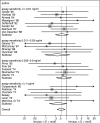Diagnosis of endotoxemia with gram-negative bacteremia is bacterial species dependent: a meta-analysis of clinical studies
- PMID: 19794055
- PMCID: PMC2786621
- DOI: 10.1128/JCM.01189-09
Diagnosis of endotoxemia with gram-negative bacteremia is bacterial species dependent: a meta-analysis of clinical studies
Abstract
Endotoxemia is undetectable for up to 60% of cases of bacteremia caused by gram-negative (GN) species, a discordance attributed to the limitations of the Limulus assay for endotoxemia. The lipid A structure of the endotoxin molecule is critical for the sensing of GN bacteria by the host immune system although not so for sensing by the Limulus assay. The lipid A structure of commensal Enterobacteriaceae is hexa-acyl, whereas non-Enterobacteriaceae have a broader range of structures. By using a previously published classification of lipid A structures (R. S. Munford, Infect. Immun. 76:454-465, 2008), the association of endotoxemia with bacteremia caused by GN organisms is reexamined for 580 GN bacteremic patients from 46 studies. Endotoxemia was less commonly detected for cases of bacteremia caused by Salmonella enterica serovar Typhi (four studies; 15 of 55 cases of bacteremia [27%]) than for cases of bacteremia caused by Neisseria meningitidis (five studies; 69 of 84 cases [82%]) and Pseudomonas pseudomallei (one study; 38 of 41 cases [93%]) among studies restricted to those with specified cases of bacteremia caused by GN organisms. Among 23 unrestricted studies, endotoxemia was less commonly detected for cases of bacteremia with a commensal member of the Enterobacteriaceae (104 of 240 cases [43%]) than with non-Enterobacteriaceae (59 of 100 cases [59%]) (summary odds ratio, 0.53 [90% confidence interval, 0.33 to 0.85]). This finding is consistent across all the unrestricted studies, even including studies with seemingly contrary results for endotoxemia diagnosis among cases of bacteremia caused by GN bacteria overall. Surprisingly, with bacteremia caused by commensal Enterobacteriaceae, the diagnosis of endotoxemia appears to be unrelated to the Limulus assay sensitivity. Across these 45 studies, the association of endotoxemia with GN bacteremia is variable but consistent for different types of GN bacteremia.
Figures

Similar articles
-
Prognostic value of endotoxemia in patients with Gram-negative bacteremia is bacterial species dependent.J Innate Immun. 2013;5(6):555-64. doi: 10.1159/000347172. Epub 2013 Apr 13. J Innate Immun. 2013. PMID: 23594418 Free PMC article.
-
Endotoxemia as a diagnostic tool for patients with suspected bacteremia caused by gram-negative organisms: a meta-analysis of 4 decades of studies.J Clin Microbiol. 2015 Apr;53(4):1183-91. doi: 10.1128/JCM.03531-14. Epub 2015 Jan 28. J Clin Microbiol. 2015. PMID: 25631796 Free PMC article.
-
Endotoxemia and mortality prediction in ICU and other settings: underlying risk and co-detection of gram negative bacteremia are confounders.Crit Care. 2012 Aug 7;16(4):R148. doi: 10.1186/cc11462. Crit Care. 2012. PMID: 22871090 Free PMC article. Review.
-
Concordance of endotoxemia with gram-negative bacteremia in patients with gram-negative sepsis: a meta-analysis.J Clin Microbiol. 1994 Sep;32(9):2120-7. doi: 10.1128/jcm.32.9.2120-2127.1994. J Clin Microbiol. 1994. PMID: 7814535 Free PMC article.
-
Endotoxemia-menace, marker, or mistake?J Leukoc Biol. 2016 Oct;100(4):687-698. doi: 10.1189/jlb.3RU0316-151R. Epub 2016 Jul 14. J Leukoc Biol. 2016. PMID: 27418356 Free PMC article. Review.
Cited by
-
Association between periodontitis treatment and dementia in Taiwanese adults.BMC Oral Health. 2023 Dec 6;23(1):969. doi: 10.1186/s12903-023-03551-5. BMC Oral Health. 2023. PMID: 38057760 Free PMC article.
-
Comparative Study of Plasma Endotoxin with Procalcitonin Levels in Diagnosis of Bacteremia in Intensive Care Unit Patients.Chin Med J (Engl). 2016 Feb 20;129(4):417-23. doi: 10.4103/0366-6999.176064. Chin Med J (Engl). 2016. PMID: 26879015 Free PMC article.
-
Establishing the safety of selective digestive decontamination within the ICU population: a bridge too far?Trials. 2023 May 17;24(1):337. doi: 10.1186/s13063-023-07356-3. Trials. 2023. PMID: 37198636 Free PMC article.
-
Does gram-negative bacteraemia occur without endotoxaemia? A meta-analysis using hierarchical summary ROC curves.Eur J Clin Microbiol Infect Dis. 2010 Feb;29(2):207-15. doi: 10.1007/s10096-009-0841-2. Epub 2009 Nov 29. Eur J Clin Microbiol Infect Dis. 2010. PMID: 20084488
-
Prognostic value of endotoxemia in patients with Gram-negative bacteremia is bacterial species dependent.J Innate Immun. 2013;5(6):555-64. doi: 10.1159/000347172. Epub 2013 Apr 13. J Innate Immun. 2013. PMID: 23594418 Free PMC article.
References
-
- Adinolfi, L. E., R. Utili, G. B. Gaeta, P. Perna, and G. Ruggiero. 1987. Presence of endotoxemia and its relationship to liver dysfunction in patients with typhoid fever. Infection 15:359-362. - PubMed
-
- Ahmed, T., M. A. Azam, N. Armed, K. M. Jamil, F. Hassan, N. Ogura, H. Tamura, and T. Yokochi. 2004. Detection of endotoxin in sera from children hospitalized for treatment of diarrhea in Bangladesh. J. Endotox. Res. 10:223-228. - PubMed
-
- Bion, J. F., I. Badger, H. A. Crosby, P. Hutchings, K. L. Kong, J. Baker, P. Hutton, P. McMaster, J. A. Buckels, and T. S. Elliott. 1994. Selective decontamination of the digestive tract reduces gram-negative pulmonary colonization but not systemic endotoxemia in patients undergoing elective liver transplantation. Crit. Care Med. 22:40-49. - PubMed
-
- Brandtzaeg, P., P. Kierulf, P. Gaustad, A. Skulberg, J. N. Bruun, S. Halvorsen, and E. Sorensen. 1989. Plasma endotoxin as a predictor of multiple organ failure and death in systemic meningococcal disease. J. Infect. Dis. 159:195-204. - PubMed
Publication types
MeSH terms
LinkOut - more resources
Full Text Sources

